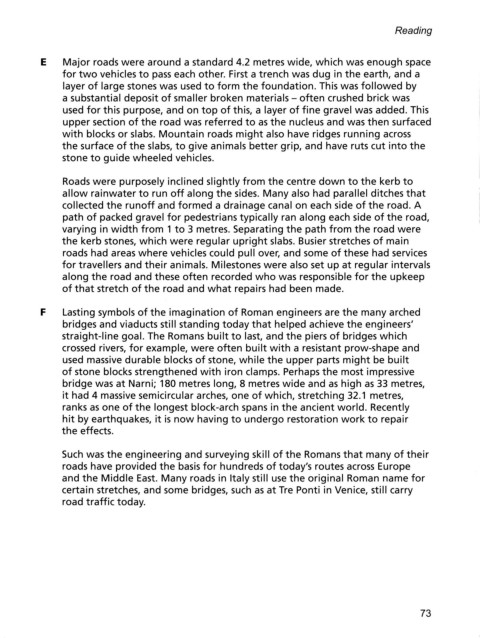Page 368 - Cam General 15-16-17-18-19
P. 368
Reading
E Major roads were around a standard 4.2 metres wide, which was enough space
for two vehicles to pass each other. First a trench was dug in the ea 「th, and a
layer of large stones was used to form the foundation. This was followed by
a substantial deposit of smaller broken materials - often crushed brick was
used for this purpose, and on top of this, a layer of fine gravel was added. This
upper section of the road was referred to as the nucleus and was then surfaced
with blocks or slabs. Mountain roads might also have 「idges running k「oss
the surface of the slabs, to give animals better grip, and have ruts cut into the
stone to guide wheeled vehicles.
Roads were purposely inclined slightly from the centre down to the ke「b to
allow rainwater to run off along the sides. Many also had parallel ditches that
collected the runoff and fo「med a drainage canal on each side of the road. A
path of packed gravel fo「 pedestrians typically ran along each side of the road,
varying in width from 1 to 3 metres. Separating the path from the road were
the kerb stones, which were regula 「 upright slabs. Busier stretches of main
roads had areas where vehicles could pull over, and some of these had services
for travellers and their animals. Milestones were also set up at regula 「 intervals
along the road and these often reζorded who was responsible for the upkeep
of that stretch of the road and what repairs had been made.
F Lasting symbols of the imagination of Roman engineers are the many arched
bridges and viaducts still standing today that helped achieve the engineers’
st「aight-line goal. The Romans built to last, and the piers of bridges which
crossed rivers, for example, were often built with a resistant prow-shape and
used massive durable blocks of stone, while the upper pa 同s might be built
of stone blocks strengthened with iron clamps. Perhaps the most impressive
bridge was at Narni; 180 metres long, 8 metres wide and as high as 33 metres,
it had 4 massive semicircular arches, one of which, st「etching 32.1 met「es,
ranks as one of the longest block-arch spans in the ancient world. Recently
hit by earthquakes, it is now having to undergo restoration work to repair
the effects.
Such was the engineering and surveying skill of the Romans that many of their
roads have provided the basis for hundreds of today’s routes ac「oss Europe
and the Middle East. Many roads in Italy still use the original Roman name for
certain stretches, and some bridges, such as at Tre Ponti in Venice, still carry
road t「attic today.
73

